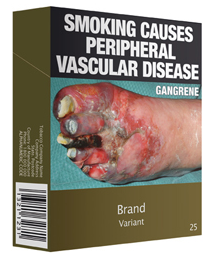The graphic images featuring gangrenous toes and dying patients portrayed on cigarette packet need to be changed regularly to maintain their impact as a deterrent to smoking, public health researchers warn.

One of the graphic health warnings mandated in Australia since December 2012.
A new survey of thousands of Australians reveals the public’s limited awareness of many serious harms of tobacco, write Professor Melanie Wakefield and colleagues in a research letter published in the MJA.
They surveyed 1806 adults on their perception of the likelihood that smoking increased the risk of developing 23 different health conditions, finding less than two thirds linking smoking to six types of cancer.
The majority of participants considered smoking was “likely” or “very likely” to raise the risk of lung cancer, throat cancer and mouth cancer (91%, 89%, 88% of participants respectively).
However just 27% made the link for rheumatoid arthritis and 31% made the connection for acute leukaemia.
There were only nine health conditions for which two thirds or more of survey participants considered smoking a likely risk factor.
“The findings reveal the limited awareness of many serious harms of tobacco, and the considerable potential for further educating Australians,” write Professor Melanie Wakefield and colleagues from Cancer Council Victoria’s centre for behavioural research.
Graphic health warnings, they write, are a critical component of comprehensive tobacco control programs. They are also a highly cost-effective for increasing the knowledge about harms of tobacco.
But the images currently used on packaging have been in circulation since December 2012, and they “require updating regularly to maintain salience and impact”.
According to the Department of Health’s website there are two sets of seven health warnings which manufacturers must include on packaging, to be alternated every 12 months.
The researchers note that the federal government is currently reviewing the images, and that it will be important in deliberations on future images to determine which harms should be depicted based on population awareness and “identifying those with the greatest potential for knowledge gains”.